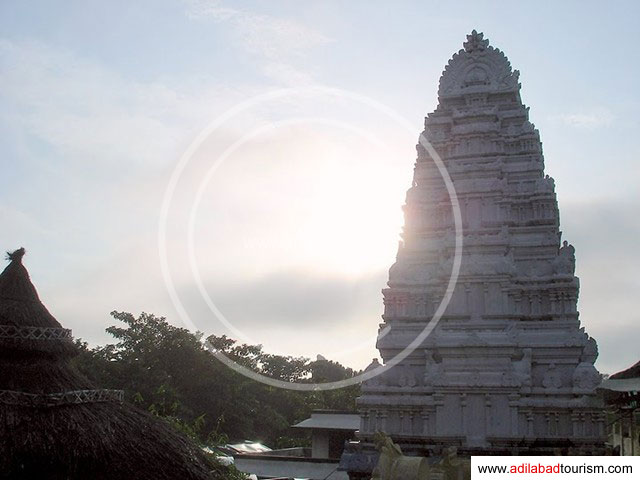Ø Dnyana Saraswati Temple is a Hindu temple of Goddess Saraswati located on the banks of Godavari River
Ø It is one of the two famous Saraswati temples in India
Ø Saraswati is the Hindu Goddess of Knowledge and Learning. Children are brought to the temple for the learning ceremony called as Akshara abyasam.
Ø Basar is a census town in the Adilabad district in the state of Andhra Pradesh, India
Origin
Ø According to legend, Maharishi Vyasa and his disciples and sage Śuka decided to settle down in a cool and serene atmosphere after the Kurukshetra War.
Ø In the quest for a peaceful abode, he came to Dandaka forest and, pleased with serenity of the region, selected this place.
Ø After his ablutions in the Godavari, Maharishi Vyasa used to bring three fistful of sand and place it in three small heaps and made images of Saraswati, Lakshmi and Kali with his mystic power and later conducted prayers.
Ø This idol made of sand has its face smeared with turmeric.
Ø Eating a little bit of this turmeric paste, it is believed, will enhance one's wisdom and knowledge.
Ø Since Maharishi Vyasa spent considerable time in prayers, the place was then called "Vasara" and turned into Basara due to the influence of the Marathi language in the region.
Ø However, according to the Brahmanda Purana, the poet Valmiki installed Saraswati and wrote Ramayana here.
Ø There is a marble image of Valmiki and his Samādhi near the temple.
Ø It is also believed that this temple is one of the three temples constructed near the confluence of the Manjira and Godavari rivers by Ashtrakutas.
Ø Historically, 'Bijialudu' a Karnataka king, who ruled the province of Nandagiri
The Temple Today
Ø Many pilgrims come to Basara to perform the "Akshara abhyasam" ceremony for the children before they start formal school education.
Ø The children perform the exercise of letters, and devote books, pens, pencils notebooks to the goddess of knowledge.
Ø The Puja at the temple starts at 4 am in morning with Abhishekam which carries on for an hour.
Ø At 5 o'clock they start the Alankarana whereby the new sarees are adorned to the goddesses. The whole atmosphere is very pious and pure.
Ø At 6 am, in the rays of the morning sun, the aarti starts at the temple after which the prasadam is given to the devotees.
Ø Special poojas and celebrations are held at the temple during Maha Shivaratri, beginning 15 days before (Vasantha Panchami) and continuing 3 days after the festival.
Ø The temple also has a Mahalakshmi idol situated on the 1st floor very near to the main temple. Devotees often go to the nearby mountain which has an Idol of Goddess Saraswati on the top of the rock.
Ø The image of Lakshmi stands besides the Goddess Saraswati in the sanctum sanctorum.
Ø Due to the presence of Saraswati, Lakshmi and Kali, Basara is considered as the abode of the divine trinity.
Ø Since the 6th century, Basar has been a pilgrimage centre for the Hindus. However, the present structure of the temple is believed to have been erected by Chalukya kings.
Ø In the sanctum sanctorum, the idol of Goddess Sarasvati adorns the sight, along with Goddess Lakshmi.
Ø In the 17th century, the idols of the temple were reinstated by a chieftain of Nandagiri (Nandeed) subsequent to destruction caused by the Muslim invaders.
Ø There is nothing extraordinary about temple's architecture yet its popularity is certainly creditable.
Ø Pilgrims from far and near come to pay their homage to the 'Goddess of Wisdom'.
Ø Basant Panchami and Navaratri are the major festivals observed at the temple. 'Akshara Gnana' is a special ritual, in which devotees bring their children to the temple.
Ø The significance of the ritual lies in the fact that it marks the formal starting of child's education. The child is given little bit of turmeric paste to taste, believing that it will clear his/her vocal chords for better learning.
Ø The Goddess answers all the prayers of the committed devotees, filling their life with bliss and happiness.
History
Ø The temple was built by Sage Veda Vyasa.
Ø During the period from 11th century to 18th century the temple and idols of goddess are attempted to destroy by Moghal Nawabs named Hanid Shahi, Kuthub Shahi, Barid Shahi.
Ø At that time one young man named Sri Makkaji Patel who belongs to Veera Shaiva of Renukapuram has tried to protect the temple from the attacks made by the Nawabs with the help of a gang of youngstars belonging to Ravindrapuram, Mahathpuram, Ratnapuram, Vyasapuram.
Ø Under the leadership of Makkaji Patel, the temple was protected from Muslims invasions.

No comments:
Post a Comment